博文
Biology of spiders : metabolism 02 毒腺和毒性
|||
Venom Glands and Toxicity
Spiders belong to the actively poisonous animals (i.e., they use their venom offen- sively to paralyze or to kill their prey). The quick immobilization is certainly the primary function of the venom—the lethal effect is only secondary (Friedel, 1987; Friedel and Nentwig, 1989).
蜘蛛属于剧毒动物(即它们经常用毒液麻痹或杀死猎物)。快速固定猎物(麻痹猎物)当然是毒液的主要功能--致死作用只是次要的(Friedel,1987;Friedel和Nentwig,1989)。
All spiders except for the uloborids, and the small holarchaeids possess a pair of venom glands, usually located in the prosoma (figs. 3.3, 3.4). The claim that the ancient Mesothelae lack venom glands (Haupt, 2003), has recently been refuted (Foelix and Erb, 2010). Each venom gland consists of a long, cylindrical part and an adjoining duct, which terminates at the tip of the cheliceral fang (fig. 2.6). A conspicuous muscle layer surrounds the body of the gland and expels the venom rapidly as the muscle contracts (fig.3.4b,c). The muscle fibers are cross-striated and have their own motor nerves, which facilitates the rapid triggering of venom release. The glandular epithelium itself is also innervated (Järlfors et al., 1971); possibly this nervous supply stimulates or regulates the synthesis of venom.
除 uloborids和小的 holarchaeids 外,所有蜘蛛都有一对毒腺,通常位于头胸部(figs. 3.3, 3.4)。关于古代中纺亚目没有毒腺的说法(Haupt,2003),最近被驳斥(Foelix and Erb,2010)。每个毒腺由一个长长的圆柱形部分和一个相邻的导管组成,该导管终止于螯牙的尖端(fig.2.6)。腺体周围有一层明显的肌肉层,当肌肉收缩时会迅速排出毒液(fig.3.4b,c)。肌肉纤维是横纹的,有自己的运动神经,这有助于快速触发毒液释放。腺上皮本身也受到神经支配(Järlfors等人,1971);这种神经供应可能刺激或调节毒液的合成。
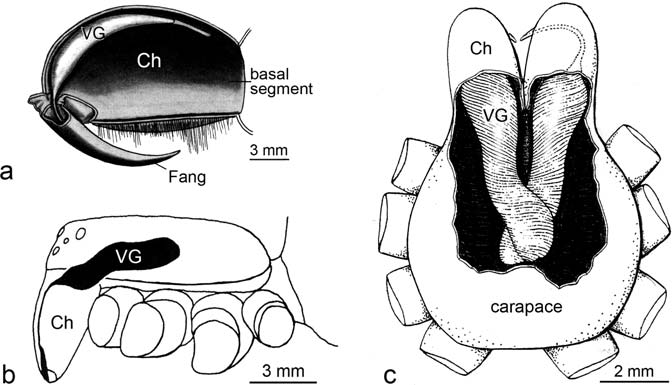
Figure 3.3
(a) Position of a venom gland within the basal segment of a chelicera in a tarantula, lateral view. (After Gerhardt and Kaestner, 1938.) (b) Position of the venom glands in Cupiennius, lateral view. (After Malli et al., 1993). (c) Position of the venom glands (VG) in Dolomedes, dorsal view of the prosoma. Ch = chelicera. (After Kaston, 1972).
(A)毒腺在捕鸟蛛侧面视图中的位置。(After Gerhardt and Kaestner, 1938.)。(B)Cupiennius的毒腺位置,侧视。(After Malli et al., 1993)。(C)毒腺(VG)在Dolomedes内的位置,头胸甲的背侧视图。CH=螯肢Chelicera)。(After Kaston, 1972)。
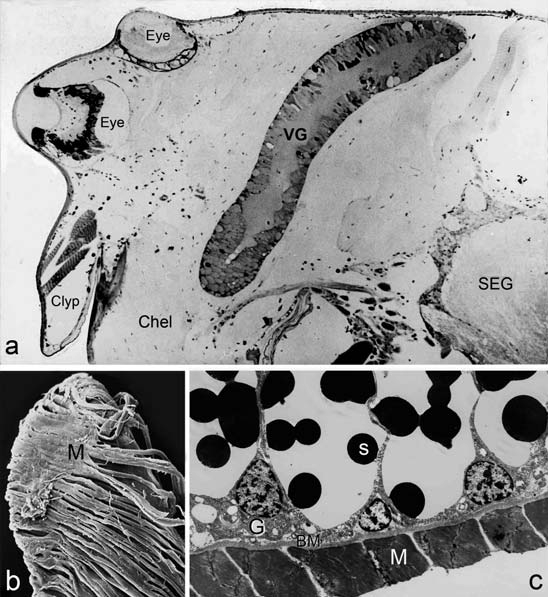
(a) Prosoma of a theridiid spider, longitudinal section. The large venom glands (VG) extend far into the carapace. Chel = chelicera, Clyp = clypeus, SEG = supraesophageal ganglion. 100x. (b) A strong muscle layer (M) surrounds the body of the venom gland. 200x. (c) The wall of the venom gland in longitudinal section: the muscle layer (M) is connected via a basal membrane (BM) to the glandular cells (G). Secretory droplets (S) containing venom accumulate toward the lumen of the gland. 2,800 x.
(A)一种球蛛的前体,纵切面。大毒腺(VG)延伸到头胸甲内很远。Chel=chelicera,CLYP=clypeus,SEG=食管上神经节。100倍。
(B)强烈的肌肉层(M)包围着毒腺的本体。200倍。
(C)毒腺纵切面壁:肌层(M)通过基膜(BM)与腺细胞(G)相连。含有毒液的分泌液滴(S)向着腺体的管腔聚集。2800 x。
In the large tarantulas (mygalomorphs), the venom glands are quite small and lie inside the chelicerae (fig. 3.3a). In contrast, most labidognath spiders have relatively large venom glands that may extend out of the chelicerae and reach far into the cephalothorax (fig. 3.4a). In some extreme cases (Filistata, for example), the glands may be even larger and subdivided into lobules. The most curious specialization is found in the spitting spider Scytodes (fig. 3.5), in which the gland consists of an anterior part that produces the venom and a posterior part that produces silk and a gluelike substance (Kovoor and Zylberberg, 1972). Scytodes catches its prey by quickly spitting silk and glue onto it (Monterosso, 1928; Dabelow, 1958), thereby both entangling the prey’s appendages and fixing it to the ground. High speed video images (1000 frames/s) showed that the silk-glue ejection is very fast, close to 30 m/s, and lasts only for 30 ms (Suter and Stratton, 2009). Upon contact with the prey, the silk contracts by about 50%, which helps immobilize the prey. The slow- motion pictures also revealed how the zigzag pattern (fig. 3.6) comes about: the chelicerae are lifted upward, producing the vertical component of the pattern, while a rapid oscillation (300–1800 Hz) of the cheliceral fangs produces the horizontal spread. It is still unclear whether the ejected venom has any effect on the captured prey (Clements and Li, 2005).
在大型捕鸟蛛(原蛛下目)中,毒腺相当小,位于螯肢内(fig.3.3a)。相反,大多数labidognath蜘蛛都有相对较大的毒腺,这些毒腺可以延伸出螯肢并延伸到很远的头胸(fig.3.4a)。在某些极端情况下(例如,Filistata),腺体可能更大,并细分成小叶。最奇特的特化是在吐唾液的蜘蛛Scydes(fig.3.5)中发现的,它的腺体由产生毒液的前部和产生丝和胶状物质的后部组成(Kovoor and Zylberberg, 1972)。Scydes通过快速吐出丝和胶水来捕捉猎物(Monterosso, 1928; Dabelow, 1958),从而既缠绕了猎物的附肢,又将猎物固定到地面。高速视频图像(1000帧/秒)显示,丝胶喷射非常快,接近30m/s,持续时间仅为30ms(Suter和Stratton,2009)。当与猎物接触时,丝收缩约50%,这有助于固定猎物。慢动作图片还揭示了之字形图案(fig.3.6)是如何产生的:螯肢向上抬起,产生图案的垂直分量,而螯牙的快速摆动(300-1800 Hz)产生水平扩展。目前还不清楚喷出的毒液是否对捕获的猎物有任何影响(Clements and Li,2005)。
Chemically, spider venom is heterogeneous in that it may contain many different substances. It is a mixture mostly of large, neurotoxic polypeptides (molecular weight 5,000–13,000) and smaller biogenic amines and amino acids; proteolytic enzymes may also be present (Kaiser and Raab, 1967; Habermehl, 1975; Bachmann, 1976). Because almost all spiders have venom glands, they are all potentially poisonous—at least with regard to their normal prey. However, only about 200 of the 40,000 species of spiders are dangerously poisonous to humans (Maretic, 1975; Diaz, 2004). And only four genera (Atrax, Latrodectus, Loxosceles, Phoneutria) are known to cause potentially deadly bites (Isbister et al., 2003).
在化学上,蜘蛛毒液是异质的,因为它可能含有许多不同的物质。它主要是大的神经毒性多肽(分子量5,000-13,000)和较小的生物胺和氨基酸的混合物;也可能存在蛋白水解酶(Kaiser和Raab,1967;Habermehl,1975;Bachmann,1976)。因为几乎所有的蜘蛛都有毒腺,所以它们都有潜在的毒性--至少就它们正常的猎物而言是这样。然而,在40,000种蜘蛛中,只有大约200种对人类有危险(Maretic,1975;Diaz,2004)。只有四个属(Atrax,Latrodectus,Loxosceles,Phoneutria)已知会引起潜在的致命咬伤(Isbister et al., 2003)。
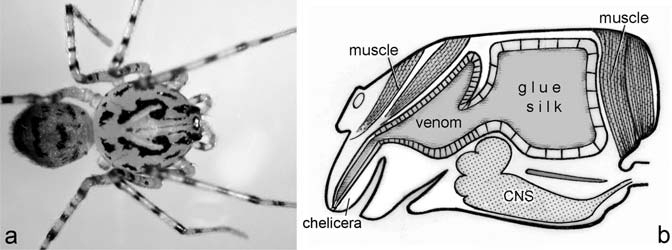
Figure 3.5
(a) Dorsal view of the spitting spider Scytodes; note the feeble legs and the massive prosoma with distinct markings (Photo: Erb) (b) Longitudinal section of the prosoma of Scytodes. The enormous venom glands consist of an anterior portion that produces venom and a posterior part that synthesizes a gluey substance. Rapid contraction of the prosomal muscles squirts out a mixture of venom and glue from the chelicerae. CNS = central nervous system. (After Millot, 1949.)
图3.5(A)吐出的蜘蛛Scydes的背面图;注意虚弱的腿和有明显斑点的巨大头胸甲(Photo: Erb)(B)Scydes头胸部的纵切面。巨大的毒腺由产生毒液的前部和合成胶状物质的后部组成。前体肌肉的快速收缩会从螯肢中喷出一种毒液和胶水的混合物。CNS=中枢神经系统。(After Millot, 1949.)
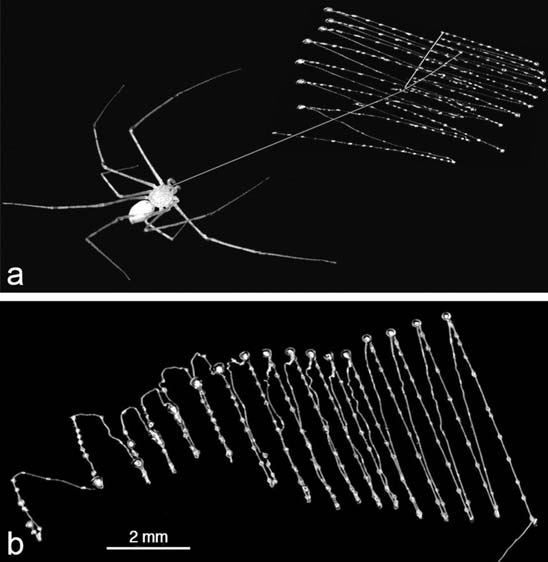
Figure 3.6
(a, b) Spitting pattern of a Scytodes with the typical zigzag pattern of the capture threads. (Photos: Suter.)
Scytodes的吐痰图案:捕获线的典型之字形图案(Photos: Suter.)。
The prime example of a spider dangerous to humans is certainly the black widow spider, Latrodectus mactans, from the family Theridiidae (fig. 3.7a, b). The bite itself is not particularly painful and often is not even noticed (Maretic, 1983, 1987). The first real pain is felt after 10–60 minutes in the regions of the lymph nodes, from where it spreads to the muscles. Strong muscle cramps develop, and the abdominal muscles become very rigid (this is an important diagnostic feature). Another typical symptom is a contorted facial expression, called facies latro- dectismi, which refers to a flushed, sweat-covered face, swollen eyelids, inflamed lips, and contracted masseter muscles. If the breathing muscles of the thorax become affected, this can eventually lead to death. Besides the strong muscle pain, the black widow spider venom (BWSV) also elicits psychological symptoms, which range from anxiety feelings to actual fear of death. Apparently the toxin can pass the blood-–brain barrier and directly attack the central nervous system.
蜘蛛对人类危害最大的例子当然是来自球蛛科的黑寡妇蜘蛛Latrodectus mactans (fig.3.7a,b)。咬伤本身并不特别痛,通常甚至没有人注意到(Maretic,1983,1987)。第一次真正的疼痛是在10-60分钟后在淋巴结区域感受到的,从那里扩散到肌肉。出现强烈的肌肉痉挛,腹部肌肉变得非常僵硬(这是一个重要的诊断特征)。另一个典型的症状是扭曲的面部表情,称为facies latrodectismi,指的是面部红肿、汗水覆盖的脸、眼睑肿胀和咀嚼肌收缩。如果胸部的呼吸肌受到影响,最终可能会导致死亡。除了强烈的肌肉疼痛,黑寡妇蜘蛛毒液(BWSV)还会引起从焦虑到实际恐惧死亡的心理症状。显然,这种毒素可以通过血脑屏障,直接攻击中枢神经系统。
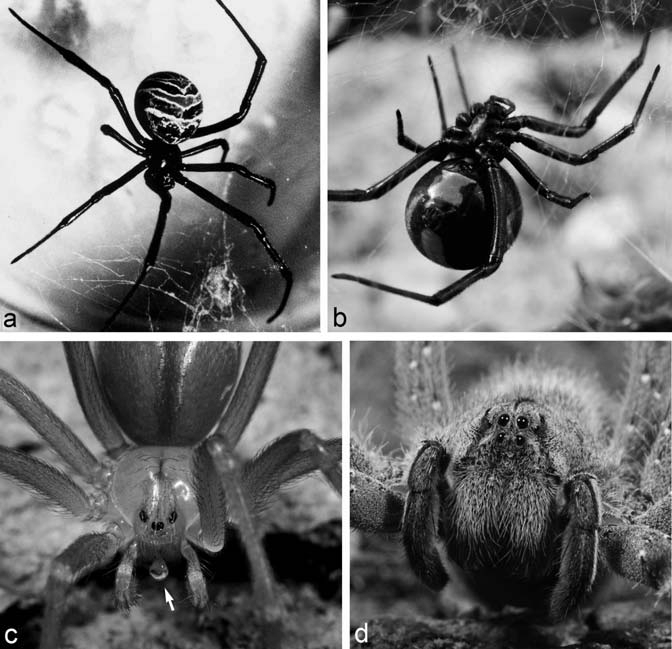
Figure 3.7
Dangerous poisonous spiders. (a) A Black Widow (Latrodectus) from South America, dorsal aspect. The black abdomen has contrasting white and red chevron markings.
(a) A North American black widow (Latrodectus mactans) with the typical (red) hourglass mark on the ventral side of the abdomen. (c) Portrait of a brown recluse spider (Loxosceles); note the six eyes and the droplet of venom hanging between the chelicerae (arrow). (d) Portrait of the ctenid Phoneutria fera, a rather aggressive spider from South America. (Photos b–d: Rast.)
危险的毒蜘蛛。(A)来自南美洲的黑寡妇(Latrodectus),背面观。黑色的腹部有对比鲜明的白色和红色的人字形斑纹。(A)一种北美黑寡妇(Latrodectus mactans),腹部腹侧有典型的(红色)沙漏斑纹。(C)一只棕色隐居蜘蛛的肖像(Loxosceles);请注意六只眼睛和悬挂在螯肢之间的毒液滴(箭头)。(D)南美洲一种颇具攻击性的蜘蛛Ctenid Phoneutria fera的肖像。(Photos b–d: Rast.)
Without any treatment the symptoms will last for about 5 days, and a complete recovery may take weeks. About 80 years ago, lethality was 5% in the United States (Thorp and Woodson, 1945), but since 1970 it is less than 1% (Zahl, 1971). The best treatment against a bite from a black widow is a combination of calcium gluconate with opioids and benzodiazepines plus an antivenom (McCrone and Netzloff, 1965; R. F. Clark, 2001). Calcium causes the pain to subside quickly, and the antidote binds to the toxin. The patient feels relieved within 10–20 minutes and will recover within a few days (Isbister and Gray, 2003).The venom (BWSV) is a neurotoxin that affects the neuromuscular endplates (fig. 4.30b) but also affects synapses in the central nervous system. The synaptic vesicles become completely depleted, causing a permanent blockage of the synapse (Clark et al., 1972; Griffiths and Smyth, 1973; Tzeng and Siekevitz, 1978;Wanke et al., 1986). One component of the poison (a-latrotoxin) binds to a presynaptic receptor of cholinergic synapses (Meldolesi et al., 1986). This is in contrast to toxins in orb-web spiders, which act on synapses that use glutamate as neurotrans- mitter (Kawai et al., 1982; Michaelis et al., 1984). Over the past years a number of spider toxins have been used extensively in neurobiological research because they block specific ion channels (e.g., for Ca2+) of the cell membrane (Adams et al., 1989; Jackson and Parks, 1989).
如果不进行任何治疗,这些症状将持续大约5天,完全恢复可能需要数周时间。大约80年前,美国的致死率是5%(Thorp and Woodson,1945),但自1970年以来,这一数字不到1%(Zahl,1971)。针对黑寡妇咬伤的最佳治疗方法是葡萄糖酸钙与阿片类药物结合、以及苯二氮卓类药物和抗蛇毒血清的结合(McCrone and Netzloff, 1965; R. F. Clark, 2001)。钙会使疼痛迅速消退,解毒剂会与毒素结合。患者在10-20分钟内感觉缓解,并将在几天内恢复(伊斯比斯特和格雷,2003年)。蛛毒是一种神经毒素,影响神经肌肉终板(fiG.4.30b),但也影响中枢神经系统中的突触。突触小泡变得完全耗尽,导致突触的永久性阻塞((Clark et al., 1972; Griffiths and Smyth, 1973; Tzeng and Siekevitz, 1978;Wanke et al., 1986)。毒素的一种成分(a-乳头状毒素)与胆碱能突触的突触前受体结合(Meldolesi等人,1986年)。这与圆网蜘蛛中的毒素形成对比,后者作用于使用谷氨酸作为神经传递因子的突触上(Kawai et al., 1982; Michaelis et al., 1984)。在过去的几年中,许多蜘蛛毒素被广泛用于神经生物学研究,因为它们阻断细胞膜的特异性离子通道(例如,钙离子通道) (Adams et al., 1989; Jackson and Parks, 1989)。
The lethal dose 50 (LD50) is usually given as a measure for the toxicity of a given substance. This term refers to the dosage of venom that will kill 50% of injected experimental animals. For the venom of Latrodectus mactans, the LD50 for a mouse is 0.0009 mg/g body weight. As can be seen in table 3.1, however, susceptibility to the venom varies greatly among different animals (Maroli et al., 1973).
致死剂量50(LD50)通常用来衡量特定物质的毒性。这个术语指的是毒液的剂量,可以杀死50%注射毒液的实验动物。对美国毒蛛Latrodectus mactans的毒液来说,小鼠的LD_(50)为0.0009毫克/克体重。然而,如表3.1所示,不同动物对毒液的敏感性差异很大(Maroli等人,1973年)。
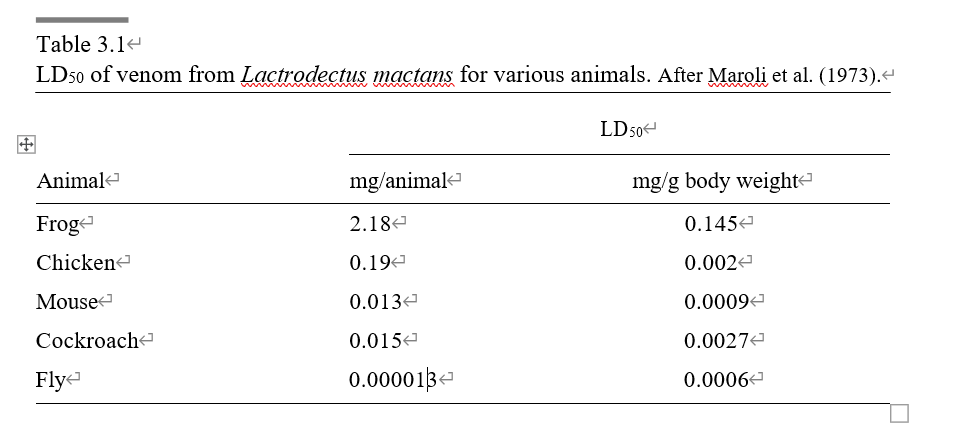
Some animals (e.g., horses, cows, and sheep), are more sensitive to a black widow spider’s bite than humans, and significant losses of cattle have been reported from such bites. Other animals, such as rats, rabbits, dogs, and goats, seem to be much hardier (Maretic and Habermehl, 1985). It is also noteworthy that bites of the closely related brown widow (Latrodectus geometricus) are not nearly as severe as those of the black widow (Müller, 1993). Symptoms are mild and tend to be restricted to the bite site and surrounding tissues.
一些动物(例如,马、牛和羊)对黑寡妇蜘蛛的咬伤比人类更敏感,而且有迹象表明,这种咬伤不会造成牛的明显损失(可以参考纪录片蜘蛛杀死牛)。其他动物,如老鼠、兔子、狗和山羊,似乎更顽强(Maretic和Habermehl,1985)。同样值得注意的是,亲缘关系密切的棕色寡妇(Latrodectus Geometricus)的咬伤远没有黑寡妇严重(Müller,1993)。症状轻微,往往局限于咬伤部位和周围组织。
Tarantulas (mygalomorphs), despite their large size, are much less dangerous than is commonly thought. A tarantula bite, it is true, is deadly for mice or insects, but for a human it is usually no worse than a wasp sting (Schanbacher et al., 1973). The venom consists of various polypeptides (molecular weight 5,000– 20,000) and is most likely a neurotoxin (Perret, 1973; Lee et al., 1974; Escoubas et al., 2000).
捕鸟蛛虽然体型很大,但其危险性比人们通常认为的要小得多。诚然,狼蛛叮咬对老鼠或昆虫是致命的,但对人类来说,它通常不会比黄蜂叮咬更糟糕(Schanbacher等人,1973)。这种毒液由各种多肽(分子量5,000-20,000)组成,很可能是一种神经毒素(Perret,1973;Lee等人,1974;Escoubas等人,2000)。
It might be added that American tarantulas are rather docile and bite only if provoked, whereas African (Pterinochilus) and Asiatic species (Poecilotheria) are a bit more aggressive and can inflict painful bites. Although it may be safely said that a tarantula bite is not dangerous to humans, it is usually deadly for dogs (Isbister et al., 2003).
可以补充的是,美洲捕鸟蛛相当温顺,只有在被激怒时才会咬人,而非洲捕鸟蛛和亚洲捕鸟蛛则更具攻击性,可以引起令人痛苦的叮咬。虽然可以安全地说狼蛛咬伤对人类没有危险,但它通常对狗是致命的(Isbister等人,2003年)。
The European tarantulas (Lycosidae; fig. 1.9) have never deserved their bad reputation, which has stuck to them since the Middle Ages (Crome, 1956b). The symptoms of tarantism were probably related to many other causes ranging from other spider bites, notably those of the black widow, to epilepsy. However, some tropical lycosid spiders may well be dangerous, such as Lycosa erythrognatha of Brazil (Lucas, 1988). After sustaining a bite, the skin surrounding the injured area becomes necrotic, and secondary bacterial infections are likely to occur (Bücherl, 1956).
欧洲捕鸟蛛(Lycosidae;fig.1.9)从未配得上它们的坏名声,这一点自中世纪以来就一直困扰着它们(Crome, 1956b)。跳舞病的症状可能与许多其他原因有关,从其他蜘蛛咬伤,特别是黑寡妇的咬伤,到癫痫。然而,一些热带狼蛛很可能是危险的,例如巴西的狼蛛 Lycosa erythrognatha (Lucas,1988)。在持续咬伤后,受伤区域周围的皮肤会坏死,很可能会发生继发性细菌感染(BüCherl,1956)。
Another well-known spider whose bite is much feared is the American brown recluse Loxosceles reclusa (Sicariidae; fig. 3.7c). The bite causes local swelling as well as necrosis of the skin (Sams et al., 2001). The responsible enzyme is a sphingomy- elinase that can cause a deep wound (Kurpiewski et al., 1981). The venom is also hemolytic (Bernheimer et al., 1985), and this may lead to kidney failure and sometimes to death. Overall, however, most Loxosceles bites are harmless (Vetter, 2008; Vetter and Isbister, 2008).
另一种被咬伤的著名蜘蛛是美国棕色隐居蜘蛛Loxosceles reclusa(西里亚科;fiG.3.7c)。咬伤会引起皮肤局部肿胀和坏死(Sams等人,2001年)。负责的酶是一种鞘氨酸蛋白酶,可导致深度伤口(Kurpiewski等人,1981年)。这种毒液还具有溶血性(Bernheimer等人,1985),这可能导致肾衰竭,有时甚至死亡。然而,总的来说,大多数Loxosceles属蜘蛛咬伤都是无害的(Vetter,2008;Vetter和Isbister,2008)。
In Australia, the funnel-web spider Atrax robustus (Dipluridae or Hexathelidae) is dangerous. Effects of the bite are severe pains, shivering, muscle cramps, loss of eyesight, and paralysis of the breathing center (Gage and Spence, 1977; Spence et al., 1977). Whereas the neurotoxic venom (atracotoxin or robustoxin; Sheumack et al., 1985; Miller et al., 2000) has severe effects on primates, dogs, cats, and rab- bits are almost immune to it (Sutherland and Tibbals, 2001). In humans, only about a dozen fatal cases are known from Atrax bites over a period of 100 years (Gray, 1981; Isbister et al., 2005). An effective Atrax antivenom was released in 1981, and no deaths or adverse effects have been reported thereafter.
在澳大利亚,漏斗网蜘蛛Atrax robostus (Dipluridae or Hexathelidae)是危险的。咬伤的后果是剧烈的疼痛、颤抖、肌肉痉挛、视力丧失和呼吸中枢瘫痪(Gage和Spence,1977;Spence等人,1977)。而这一神经毒性毒液(阿特拉毒素或粗壮毒素;Sheumack等人,1985;Miller等人,2000年)对灵长类动物有严重影响,狗、猫和兔子几乎对其免疫(Sutherland和Tibbals,2001)。在人类中,在100年的时间里,只有大约12例因Atrax叮咬而死亡的病例(Gray,1981;Isbister等人,2005年)。一种有效的Atrax抗毒血清于1981年发布,此后没有死亡或不良反应的报道。
In Europe, there are two other spiders one should handle cautiously, although neither is really dangerous: Cheiracanthium (Clubionidae) and the water spider Argyroneta (Argyronetidae). Their bites are painful, but the symptoms (itching, shivering, vomiting, slight fever) disappear within 2–3 days (Habermehl, 1974; Wolf, 1988). Most of the smaller spiders, however, cannot even pierce the human skin. In those rare cases where the skin is broken (as may happen from our garden spider), the effects—local swelling, blisters, and raised body temperature—are negligible (Maretic, 1971). The rather large “Hobo” spider (Tegenaria agrestis) is feared in the United States, yet seems innocuous in Europe; it is not really clear whether its bite has any necrotic effects (Binford, 2001).
在欧洲,还有另外两种蜘蛛应该小心对待,尽管这两种蜘蛛都不是真正危险的:Cheiracanthium (Clubionidae)和水蜘蛛Argyroneta(Argyronetdae)。它们的咬伤很痛,但症状(瘙痒、颤抖、呕吐、微烧)在2-3天内就会消失(Habermehl,1974;Wolf,1988)。然而,大多数较小的蜘蛛甚至不能刺穿人的皮肤。在那些罕见的皮肤破裂的情况下(就像我们的花园蜘蛛可能发生的情况),其影响-局部肿胀、水泡和体温升高-可以忽略不计(Maretic,1971)。相当大的“流浪者”蜘蛛(Tegenaria Agrestis)在美国令人畏惧,但在欧洲似乎是无害的;尚不清楚它的咬伤是否有任何坏死效应(Binford,2001)。
Most poisonous of all are certain ctenid spiders (Phoneutria; fig. 3.7d) of South America (Bücherl, 1953, 1971; Schenberg and Pereira Lima, 1971). In contrast to most other dangerous spiders mentioned above, these ctenid spiders are rather aggressive. Their bite is very painful and can cause shock. The observed effects are tremors, sweating, accelerated heart beat, vomiting, and feeling cold and tense.
The venom is a complex mixture of aspartic acid, glutamic acid, histamine, hyaluronidase, lysine, and serotonin that targets the nervous system by activating the Na+ channels of nerve and muscle membranes (Entwistle et al., 1982; Fontana and Vital Brazil, 1985; Bucaretchi et al., 2000). One representative, Phoneutria nigriventer, injects about 8 mg (dry weight) of venom per bite. This amount would theoretically be sufficient to kill 300 mice (LD50 = 0.013 mg/animal). Nevertheless, the bite is rarely deadly for humans, probably because only small amounts of toxin are injected during a defensive bite. Most victims recover within 1–2 days, and only few require antivenom therapy. Although 2700 Phoneutria bites were reported in Brazil during the year 2006, only 0.5–1% of all people bitten showed any severe evenoming effects (Bucaretchi et al., 2008).
最有毒的是南美洲的某些栉足蛛科蜘蛛(Phoneutria;fig.3.7d) (Bücherl, 1953, 1971; Schenberg and Pereira Lima, 1971).与上面提到的大多数其他危险蜘蛛不同的是,这些 ctenid 的蜘蛛相当咄咄逼人。它们的咬伤非常痛苦,可能会引起休克。观察到的症状包括震颤,出汗,心跳加速,呕吐,感觉寒冷和紧张。这种毒液是天冬氨酸、谷氨酸、组胺、透明质酸酶、赖氨酸和5-羟色胺的复杂混合物,通过激活神经和肌肉膜的Na+通道来针对神经系统 (Entwistle et al., 1982; Fontana and Vital Brazil, 1985; Bucaretchi et al., 2000)。其中一种代表性的蜘蛛(Phoneutria Nigriventer)每咬一口大约注射8毫克(干重)的毒液。该剂量理论上足以杀死300只小鼠(LD50=0.013 mg/只)。然而,这种咬伤对人类来说很少是致命的,可能是因为在防御性咬伤过程中只注射了少量的毒素。大多数患者在1-2天内康复,只有少数人需要抗蛇毒血清治疗。虽然巴西在2006年报告了2700起被Phoneutria叮咬的事件,但只有0.5%-1%的被叮咬的人显示出任何严重的傍晚效应(Bucaretchi等人,2008年)。
The large wandering spider Cupiennius salei is one of the best studied spiders (Barth, 2002) and belongs to the same family as Phoneutria (Ctenidae). Its bite is harmless for humans, but not for arthropods. Chemically, the venom contains three molecular groups: (1) many ions and low-molecular-mass compounds such as amino acids and amines; (2) neurotoxins (CSTX, Cupiennius salei toxins), neuro- toxic enhancer peptides, and cytolytic peptides (cupiennins); and (3) a highly active hyaluronidase that acts in combination with the cytolytic peptides as a spreading agent for the neurotoxins (Kuhn-Nentwig et al., 2004).
大型游荡蜘蛛Cupiennius Salei是研究最深入的蜘蛛之一(Barth,2002),与Phoneutria(Ctenidae)同属一科。它的咬伤对人类无害,但对节肢动物不会。在化学上,这种毒液包含三个分子群:(1)许多离子和低分子化合物,如氨基酸和胺;(2)神经毒素(CSTX,Cupiennius Salei毒素)、神经毒性增强子肽和细胞溶解肽(Cupiennins);以及(3)一种高活性的透明质酸酶,它与细胞溶解肽一起作用,作为神经毒素的扩散剂(Kuhn-Nentwig等人)。
The total amount of venom present is about 12 ml/gland in female spiders; it takes more than 2 weeks to replenish an empty venom gland. Interestingly, Cupiennius does not inject more venom per bite than is necessary. Harmless prey animals receive a smaller dose of venom than strong and aggressive prey. This eco- nomical use of venom implies that the spider must know which kind of prey it is dealing with before the actual bite (Wullschleger and Nentwig, 2002). Apparently olfactory information is helpful in making the right decision (Hostettler and Nentwig, 2006). Furthermore, the most efficient spot to quickly paralyze a cricket, for instance, lies around the coxae of the front legs—and this is exactly where most of the spider bites were observed. In small prey the bite lasts rather long (3 minutes), and venom is probably injected in several small doses; in large, struggling prey more venom is applied but during a shorter bite (Boevé, 1994). Overall, it seems that Cupiennius can adjust the amount of venom to a specific prey type, thus making optimal use of the available venom (Wigger et al., 2002).
雌性蜘蛛的毒液总量约为12 ml/腺体,一个空的毒腺需要2周以上的时间才能补充。有趣的是,Cupiennius 每次咬一口都不会注射超过必要剂量的毒液。无害的猎物比强壮和攻击性强的猎物被注射的毒液剂量更小。这种毒液的经济用途意味着蜘蛛在被咬之前必须知道它面对的是哪种猎物(Wullschleger and Nentwig, 2002)。显然,嗅觉信息有助于做出正确的决定(Hostettler and Nentwig, 2006)。此外,例如,使蟋蟀迅速瘫痪的最有效的攻击点位于前腿的髋部周围-这正是观测到的大多数蜘蛛叮咬的的地方。在小型猎物中,被咬的时间相当长(3分钟),毒液可能以几个小剂量注射;在大型、挣扎的猎物中,使用更多的毒液,但咬的时间较短(Boevé,1994)。总体而言,Cupiennius 似乎可以将毒液的数量调整以此针对特定的猎物类型,从而优化利用现有的毒液(Wigger et al., 2002)。
Finally, it should be stressed that, at least statistically, spider bites are much less dangerous to humans than the poisonous stings of bees, wasps, and hornets. This is because we encounter those hymenopterans more often than spiders, and, in addition, often in swarms (Maretic, 1982).
最后,应该强调的是,至少在统计上,蜘蛛叮咬对人类的危险比蜜蜂、胡蜂和大黄蜂的有毒蜇要小得多。这是因为与蜘蛛相比,我们更容易遭遇到膜翅目昆虫,它们常常成群结队(Maretic,1982)。
From a biological view point, the venom of spiders is primarily designed to paralyze their prey (i.e., mainly insects); defensive bites against large animals (including humans) are only secondary. Some spiders possess strong and quickly acting venom; others have much less effective toxins. Among the first category are spiders (e.g. Thomisidae and Mimetidae) that attack potentially dangerous prey such as bees, bumblebees, or other spiders. Many web spiders, which carefully wrap their prey before biting it, belong to the second category (fig. 6.22; Friedel, 1987). Anyone interested in the details of spider toxins and their effects can consult the web site www.arachnoserver.org.
从生物学的角度来看,蜘蛛的毒液主要是用来麻痹猎物(主要是昆虫)的;对大型动物(包括人类)的防御性咬伤只是次要的。一些蜘蛛拥有强烈且快速起作用的毒液,而另一些蜘蛛的毒素效力要小得多。在第一类的蜘蛛中(e.g. Thomisidae and Mimetidae) ,它们攻击潜在危险的猎物,如蜜蜂、大黄蜂或其他蜘蛛。许多结网蜘蛛在咬猎物之前会仔细地将其包裹起来,属于第二类 (fig. 6.22; Friedel, 1987)。任何对蜘蛛毒素及其影响的细节感兴趣的人都可以访问网站www.arachnoserver.org。
https://blog.sciencenet.cn/blog-3411995-1244967.html
上一篇:Biology of spiders :Metabolism 01
下一篇:黑腹果蝇作为捕食性天敌的人工猎物的营养品质
全部作者的其他最新博文
- • 实验2 体格检查
- • 实验1 牛乳掺伪的检验
- • 教学演练设计
- • [转载]怎样养成好习惯
- • 漏斗蛛
- • [转载]你知道你有5种不同的食欲吗?